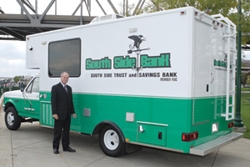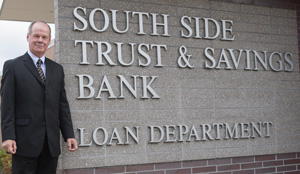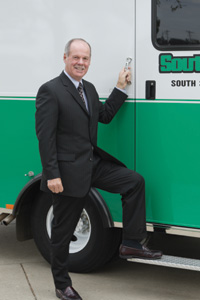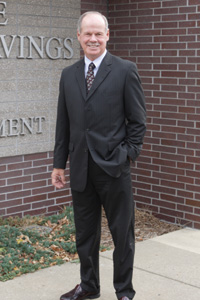
Tell us about your educational and family background. As the youngest of eleven children, what do you remember most about growing up in that large family in Pekin?
I graduated from Pekin Community High School and Illinois Central College and then attended Illinois State University and graduated from the Graduate School of Banking at the University of Wisconsin. In the middle of all this, I spent three years in the U.S. Army.
My father worked for 42 years at Keystone Steel & Wire Company, retiring the year I graduated from high school. My mother was an LPN and worked at several nursing homes in Pekin before retirement.
Growing up as the youngest of eleven children was quite an experience. There is a 21-year difference between the oldest and myself, and even though we weren’t all home at the same time, our small five-room house was very full during my early years. Being the youngest had its advantages and disadvantages. The biggest advantage was, as older siblings moved out, my parents were able to provide a few more extras for us younger children. On the other hand, getting a good seat at the dinner table was influenced by your age and size!
My wife Bernie and I have been married for two years. Both of our previous marriages were cut short by cancer after 30+ years. I have two daughters and Bernie has one. We share four wonderful grandchildren and love spending time with them. Family is very important to us and takes up a lot of our time.
Who or what influenced you to go into the banking industry? Tell us about your career path.
I started my career in 1970 with a consumer finance company. In just a few short years, Bob Stein, later the president and CEO of Prospect National Bank, influenced me to join Prospect Bank. Bob was a great mentor and helped me in the initial development of my career. With Bob, you performed or moved on. During the mid- to late 1980s, mergers and acquisitions were in high gear. Most of the smaller community banks, with the exception of South Side Trust and Savings Bank, became targets of the larger banks. I worked through four mergers before joining South Side Bank. Dan Karpowicz, current chairman of the board of South Side Bank, hired me in 1997. As former president and CEO, Karpowicz gave me the guidance and further training needed to assume my current position.
Tell about the unique services offered by South Side Bank.
Realistically, all banks offer the same products and services. The key is how you offer them. We are a locally-owned community bank that strives to give our customers competitively priced products and services coupled with excellent customer service. A lot say they have it, but we live it. As all of our decisions are made locally, we can give our customers fast, friendly and efficient service.
All members of our senior management team answer their own phones and are visible in the lobby of the bank. It is just as easy to see me as it is a teller. We do offer one service unique to our market. Our mobile bank, the Eagle Express (with built-in ATM), travels to many community events throughout the year, providing a convenient way for people to get some extra cash. It has become a great traveling billboard for South Side Bank.
 Is there a particular niche that South Side Bank is trying to serve?
Is there a particular niche that South Side Bank is trying to serve?
We are the perfect fit for small- to medium-sized businesses. Most of our lenders have lived in the Peoria area all their lives, and all are experienced bankers. They know the market and what it takes to run a successful business. We’re local, so there’s no red tape or delays in getting back to customers, which allows them to get what they need to start or grow their business and keep moving forward. We also have an excellent 50+ program called Advantage. While other financial institutions are pulling back on their 50+ programs, we actively look for ways to increase ours. We have a very competitive checking account for those who are at least 50 years old and offer great trips and seminars throughout the year. We have a Christmas party each year with over 500 attendees where we’ve brought in some of the great old dance club orchestras from Chicago to entertain for the afternoon. We love the baby boomers because so many of us are baby boomers! We know they’re looking for a good, solid, friendly bank that offers competitive products and services with a whole lot of fun thrown in!
How many branches does South Side Bank have and what territory do you cover?
South Side Bank currently has 12 full-service branches, plus our mobile bank. Our newest branch in Washington opened in October, and we are very excited to be a part of the Washington community. We also have branches in Chillicothe, Bartonville, West Peoria and East Peoria, in addition to seven branches in Peoria. Our goal is to continue expanding our branch network into other central Illinois communities.
You have gone through several bank mergers in your career. How would you describe the difference between an independent, locally-owned bank and a regional or national bank? What are the advantages or disadvantages of each?
As I mentioned earlier, I started my banking career with a community bank which later merged into a regional bank. Coming back home to South Side Bank—a community bank—fits my personality and career objectives.
Depending on your vantage point, one can list many advantages and disadvantages of both types of institutions. Although they both serve their own niches within their markets, I think a major advantage of community banks is being locally owned. Our roots are deep in Peoria and neighboring communities. Our officers, employees, directors and customers are our major shareholders and have a sizable interest in the success of our bank. Our loyalty lies with the local markets we serve, and those markets have been very loyal to South Side Bank. Our bank has been here for 85+ years, and that says a lot about our commitment to the communities we serve. From a community banker’s perspective, there is nothing that compares to being able to make all your own decisions and do it in a timely manner. At a small community bank, it’s very easy to get everyone together to make decisions and promptly get back to business.
 Would you have envisioned online banking when you began your career? How has the growth of online banking affected South Side Bank?
Would you have envisioned online banking when you began your career? How has the growth of online banking affected South Side Bank?
Well, when I began my career I didn’t even envision computers, so online banking wasn’t even on my radar! However, it has quickly become a very important part of our growth and our customers’ lives. We actively market to the 20- to 35-year-olds, and this is the way they bank. We realize we have to keep up with technology or we’ll be left behind. Both our personal and business customers expect to do their banking online—when it’s convenient for them—24/7.
You can do just about everything with online banking—download your statement, transfer money, make loan payments and pay bills. I’ve often said that one of these days someone’s going to come up with a way to make a deposit or get cash online!
We’ve been amazed at the demographics of online customers. We not only have our younger customers using online banking, but a large number of our baby boomers and seniors actively use online banking and take advantage of the bill-pay option. It reinforces the fact that computers have become a way of life.
How has the banking industry changed in the last 10 years?
The continuation of mergers and acquisitions, technology, competition and DeNovo (newly chartered) banks has changed and continues to change our industry. For the first time in more than ten years, bank mergers in 2007 will exceed 300. In 2006, 191 new banks were chartered, the most since 2000. There are 8,615 bank and thrift institutions chartered in the U.S. today. This is down from just over 11,000 ten years ago. Currently, 92 percent of all banks in the U.S. hold one billion dollars or less in assets, but the other eight percent hold 88 percent of the total assets. The rising cost for smaller community banks to comply with bank regulations and stay current with technology will fuel continued consolidations and mergers.
How has Sarbanes-Oxley affected the banking industry?
Sarbanes-Oxley was designed to promote integrity in corporate governance, financial disclosure and auditing relationships for publicly traded companies in order to protect stockholders from financial disaster caused by corporate misdeeds. The act set new requirements for auditing independence and financial reporting and controls. Although the provisions of the act are mandatory for publicly traded companies, the “trickle-down” effect extends its reach far and wide. Many provisions of the act reflect evolving corporate governance, so bank regulators have encouraged smaller, privately-held community banks to incorporate these as accepted practices. Larger community banks must comply with selected parts of the act as well. That said, Sarbanes-Oxley has had a significant effect on the banking industry.
What are your thoughts on other recently passed or currently proposed legislation affecting the banking industry?
Expanded acts and requirements under the Bank Secrecy Act/Anti-Money Laundering Act have had the most significant effect on banks in the past few years. The tragic events of 9-11 have increased tracking and reporting under these regulations. They have had such an impact on us that community banks of our size have dedicated a full-time officer to ensure compliance with this regulation.
How would you describe your management style?
I take the team approach. We have a very strong senior management team. Information is freely shared and we make most of our bank-wide decisions as a team. We have a tight management group, the members of which function very well together. We are very fortunate to have so many employees with the skills and abilities to do their jobs very well. We respect each other and others’ abilities, and when one is struggling, others will come forward to help. The final decision is mine, but the team approach generally gets the job done. We empower our front-line employees to make decisions enabling them to better serve our customers. I would be less than honest if I didn’t say that there are areas we monitor closer than others, but all in all, it works very well. With our strong senior management team, it makes my style a little easier to operate.
 What role does South Side Bank play in the community?
What role does South Side Bank play in the community?
We are very community-oriented, and this commitment has been present since South Side Bank was founded in 1922. Our officers serve on many boards of civic and charitable organizations and volunteer in many projects thoughout the area. We believe in giving back to the communities we serve. A recent example is our donation to the new Five Points Washington community center. Peoria and its surrounding areas have many needs, and we feel it’s our duty to give back to the communities who have been so good to us over the past 85 years.
We’re very proud of the fact that this is the 50th year that South Side Bank has underwritten the televised broadcast of the Santa Claus Parade. Many people don’t realize it’s the oldest continuously-run Santa Claus Parade in the nation! We realize there are many people who can’t come downtown to watch the parade in person, and we’re thrilled to be able to provide a way by which they can watch this historic event.
What do you see in the future for the Peoria area?
I’m an optimist and believe the future of the Peoria area is bright. Although statistics show that the population of the area has not grown in the last ten years, with all the new developments and the efforts of our area’s leaders, that trend will soon change.
Even though housing issues are really making the news around the country, our economy has remained strong. Housing starts are down slightly, and even though inventory is up 12 percent over last year, we still compare very favorably to the national trend. Foreclosures in the Peoria area are well below the national average. Sub-prime lending has not had the same impact on the Peoria markets that it had throughout the country. Traditional mortgage lending continues to be the financing vehicle of choice for the Peoria area real estate market.
All you have to do is look around our Tri-County Area to see all the exciting things that are happening here. I think we should all be energized by everything that is going on. It’s definitely an exciting time to live and work in the Peoria area.
What hobbies or other interests do you have outside of work?
I have three major interests in my life. They are my family, my work and golf. I am so happy that I am better at the first two than the last! My wife and I both love to play golf. We are members of the Pekin Country Club, where I am serving out my final year as president on the board of governors. It was an exciting time to help with the major renovations to the clubhouse, pro shop and golf course over the past two years. A lot of hard work and dedication from our membership has resulted in a premier country club.
We also spend as much time as possible in the Lake of the Ozarks. Bernie and I purchased a condominium on the lake last May and she spent most of the summer furnishing and decorating. We both have always loved vacationing in the Ozarks and it’s a perfect place to share with our daughters and their families. IBI

